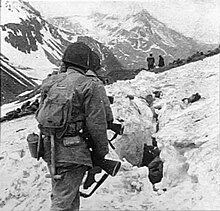See also: Territory of Alaska
Starting in the 1890s and stretching in some places to the early 1910s, gold rushes in Alaska and the nearby Yukon Territory
brought thousands of miners and settlers to Alaska. Alaska was
officially incorporated as an organized territory in 1912. Alaska's
capital, which had been in Sitka until 1906, was moved north to Juneau. Construction of the Alaska Governor's Mansion
began that same year. European immigrants from Norway and Sweden also
settled in southeast Alaska, where they entered the fishing and logging
industries.
U.S. troops navigate snow and ice during the Battle of Attu in May 1943.
The United States Lend-Lease program involved the flying of American warplanes through Canada to Fairbanks and then Nome; Soviet pilots took possession of these aircraft, ferrying them to fight the German invasion of the Soviet Union. The construction of military bases contributed to the population growth of some Alaskan cities.
Statehood
See also: Alaska Statehood Act
Statehood for Alaska was an important cause of James Wickersham
early in his tenure as a congressional delegate. Decades later, the
statehood movement gained its first real momentum following a
territorial referendum in 1946. The Alaska Statehood Committee and
Alaska's Constitutional Convention would soon follow. Statehood
supporters also found themselves fighting major battles against
political foes, mostly in the U.S. Congress but also within Alaska.
Statehood was approved by Congress on July 7, 1958. Alaska was
officially proclaimed a state on January 3, 1959.In 1960, the Census Bureau reported Alaska's population as 77.2% White, 3% Black, and 18.8% American Indian and Alaska Native.[35]
Kodiak, before and after the tsunami which followed the Good Friday earthquake in 1964, destroying much of the townsite.
Good Friday earthquake
Main article: 1964 Alaska earthquake
On March 27, 1964, the massive Good Friday earthquake killed 133 people and destroyed several villages and portions of large coastal communities, mainly by the resultant tsunamis and landslides. It was the second-most-powerful earthquake in the recorded history of the world, with a moment magnitude of 9.2. It was over one thousand times more powerful than the 1989 San Francisco earthquake.
The time of day (5:36 pm), time of year and location of the epicenter
were all cited as factors in potentially sparing thousands of lives,
particularly in Anchorage.Discovery of oil
The 1968 discovery of oil at Prudhoe Bay and the 1977 completion of the Trans-Alaska Pipeline System led to an oil boom. Royalty revenues from oil have funded large state budgets from 1980 onward. That same year, not coincidentally, Alaska repealed its state income tax.In 1989, the Exxon Valdez hit a reef in the Prince William Sound, spilling over 11 million U.S. gallons (42 megaliters) of crude oil over 1,100 miles (1,800 km) of coastline. Today, the battle between philosophies of development and conservation is seen in the contentious debate over oil drilling in the Arctic National Wildlife Refuge and the proposed Pebble Mine.


No comments:
Post a Comment